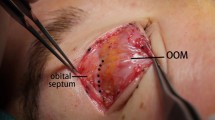Abstract
Background
This article presents a new method using a dermis–outer orbicularis fascia–orbicularis–levator (DOOL) fixation technique for double-eyelid blepharoplasty.
Methods
Our surgical technique preserves the preorbicular venous network (POVN) and uses mattress sutures to fix the dermis, outer fascia of the orbicularis oculi muscle, and orbicularis oculi muscle with pretarsal levator aponeurosis (DOOL). Between January 2016 and July 2018, 335 patients were treated with this POVN-preserving DOOL technique (321 women and 14 men; mean age, 29.6 y). The patients were followed up for 6–30 months. The complications were documented, and the overall outcomes of the upper eyelid folds were evaluated by both surgeons and patients as good, fair, or poor.
Results
Among 335 patients, 307 (91.6%) had good results, 17 (5.1%) had fair results, and 11 (3.3%) had poor results. Postoperative complications included partial (n=4) or complete (n=3) loss of the double-eyelid line and asymmetric folds (n=4). Hypertrophic/depressed scars did not occur.
Conclusions
With less invasiveness and secure internal fixation, the DOOL fixation technique with POVN preservation can achieve a stable and natural double-eyelid appearance.
Level of evidence IV
This journal requires that authors assign a level of evidence to each article. For a full description of these Evidence-Based Medicine ratings, please refer to the Table of Contents or the online Instructions to Authors www.springer.com/00266.





Similar content being viewed by others
REFERENCES
Park KS, Park DD (2017) Objective outcome measurement after upper blepharoplasty: an analysis of different operative techniques. Aesthetic Plast Surg 41(1):64–72. https://doi.org/10.1007/s00266-016-0747-1
Kim HS, Hwang K, Kim CK, Kim KK (2013) Double-eyelid surgery using septoaponeurosis junctional thickening results in dynamic fold in asians. Plast Reconstr Surg Glob Open 1(2):1–9. https://doi.org/10.1097/GOX.0b013e318293dc69
Choi Y, Eo S (2010) A new crease fixation technique for double eyelidplasty using mini-flaps derived from pretarsal levator tissues. Plast Reconstr Surg 126(3):1048–1057. https://doi.org/10.1097/PRS.0b013e3181e3b72a
Lu L, Zhu M, Luo X, Yang Q, Wang X, Yang J, Liu F (2017) Using levator aponeurosis to create physiologically natural double eyelid: a new reconstruction technique based on three key factors in double eyelid formation. Ann Plast Surg 78(5):487–491. https://doi.org/10.1097/SAP.0000000000000951
Pan L, Sun Y, Yan S, Shi H, Jin T, Li J, Zhang L, Wu S (2019) A flexible suspension technique of blepharoplasty: clinical application and comparison with traditional technique. Aesthetic Plast Surg 43(2):404–411. https://doi.org/10.1007/s00266-019-01317-5
Choi Y, Eo S (2016) Outer fascia of orbicularis oculi muscle as an anchoring target tissue in double eyelid surgery. J Craniofac Surg 27(2):322–327. https://doi.org/10.1097/SCS.0000000000002372
Kakizaki H, Takahashi Y, Nakano T, Ikeda H, Selva D, Leibovitch I (2011) The distribution of elastic fibers in the Asian upper eyelid skin. Ophthalmic Plast Reconstr Surg 27(3):201–203. https://doi.org/10.1097/IOP.0b013e3181f9df3a
Sayoc BT (1954) Plastic construction of the superior palpebral fold. Am J Ophthalmol 38(4):556–559. https://doi.org/10.1016/0002-9394(54)90707-2
Boo-Chai K (1963) Plastic construction of the superior palpebral fold. Plast Reconstr Surg 31:74–78. https://doi.org/10.1097/00006534-196301000-00010
Fernandez LR (1960) Double eyelid operation in the Oriental in Hawaii. Plast Reconstr Surg Transplant Bull 25:257–264. https://doi.org/10.1097/00006534-196003000-00007
Park JI (1999) Orbicularis-levator fixation in double-eyelid operation. Arch Facial Plast Surg 1(2):90–95. https://doi.org/10.1001/archfaci.1.2.90
Zhou X, Wang H (2019) Orbicularis-white line fixation in asian blepharoplasty: kiss technique. Aesthetic Plast Surg 43(6):1553–1560. https://doi.org/10.1007/s00266-019-01454-x
Sun W, Wang Y, Song T, Wu D, Li H, Yin N (2018) Orbicularis-tarsus fixation approach in double-eyelid blepharoplasty: a modification of park’s technique. Aesthetic Plast Surg 42(6):1582–1590. https://doi.org/10.1007/s00266-018-1218-7
Wu LW, Ye Z, Xu Y, Yu J, Wu Y (2015) Orbicularis-levator-tarsus composite suture technique in double-eyelid operation. J Plast Reconstr Aesthet Surg 68(8):1079–1084. https://doi.org/10.1016/j.bjps.2015.04.009
Shen X (2021) Full-incision double-eyelid blepharoplasty with selective neurovascular preservation method. Aesthetic Plast Surg. https://doi.org/10.1007/s00266-021-02418-w
Li G, Ding W, Tan J, Zhang B, Chen X, He B (2018) A new method for double-eyelid blepharoplasty using orbital septum. Ann Plast Surg 81(6):633–636. https://doi.org/10.1097/SAP.0000000000001650
Kim KK, Kim WS, Oh SK, Kim HS (2017) High double eyelid fold correction using wide dual-plane dissection. Ann Plast Surg 78(4):365–370. https://doi.org/10.1097/SAP.0000000000000905
Young SM, Kim YD, Kim JH, Lang SS, Woo KI (2019) Lowering of the high eyelid crease in revision upper eyelid surgery. Aesthetic Plast Surg 43(1):139–146. https://doi.org/10.1007/s00266-018-1235-6
Kim DW, Bhatki AM (2005) Upper blepharoplasty in the Asian eyelid. Facial Plast Surg Clin North Am. https://doi.org/10.1016/j.fsc.2005.06.009
Funding
This manuscript is funded by the Key Project of the Strategic International Science and Technology Innovation Cooperation, Ministry of Science and Technology, grant No.: 2019YFE020215.
Author information
Authors and Affiliations
Corresponding authors
Ethics declarations
Conflict of interest
The authors have no financial or conflicts of interest to disclose.
Ethical approval
Our experiments were in accordance with the ethical standards formulated in the Declaration of Helsinki. This study was approved by the Research Ethics Board of our Hospital.
Consent to participate
Consent was obtained from the participants responding to the follow-up surveys.
Additional information
Publisher's Note
Springer Nature remains neutral with regard to jurisdictional claims in published maps and institutional affiliations.
Supplementary Information
Below is the link to the electronic supplementary material.

266_2021_2627_MOESM1_ESM.jpg
Supplementary Figure A patient before the operation and 6 months postoperatively, with no visible scar when the eyes are closed. A series of pictures indicated the patient opening eyes and closing eyes before operation (a1, b1), 1 day (a2, b2), 5 days (a3, b3), 2 weeks (a4, b4), 1 month (a5, b5), 2 months (a6, b6), and 6 months (a7, b7) postoperatively. Swelling resolved quickly after operation, which was minimal 2 months postoperatively. (JPG 2631 kb)
Rights and permissions
About this article
Cite this article
Huang, J., Feng, Y., Li, Z. et al. Double-Eyelid Blepharoplasty: Dermis–Outer Orbicularis Fascia–Orbicularis–Levator Fixation Technique with Preorbicular Venous Network Preservation. Aesth Plast Surg 46, 231–236 (2022). https://doi.org/10.1007/s00266-021-02627-3
Received:
Accepted:
Published:
Issue Date:
DOI: https://doi.org/10.1007/s00266-021-02627-3




